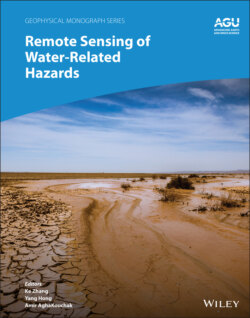Читать книгу Remote Sensing of Water-Related Hazards - Группа авторов - Страница 18
Part III: Remote Sensing of Droughts and Associated Hazards
ОглавлениеDrought poses signicant risks to ecosystems and human society. Effective drought monitoring tools are important for scientists to understand the underlying drives and mechanisms and for decision makers to develop operational strategies for drought management and mitigation.
In chapter 9, Li et al. review the current and emerging drought monitoring approaches based on remote sensing techniques. They present a case study on using remotely sensed precipitation and vegetation data for meteorological and agricultural drought monitoring in Jiangsu Province, China. This chapter also discusses the major gaps, challenges, and potential future research directions for remote sensing of drought.
In chapter 10, Zhang et al. review the definition and quantification of drought and mechanisms that control vegetation responses to it. They then introduce two methods to detect vegetation stress under drought disturbances based on remote sensing of vegetation and hydroclimatology. Yunnan Province, a key ecozone in China, is presented as a case study area to analyze drought dynamics and their impacts on ecosystem water use efficiency. This provides a valuable reference for studying and monitoring vegetation responses to drought using spaceborne optical and near‐infrared sensors.
Physical water scarcity indicates the lack of sufficient water resources to meet human and environmental demands. In chapter 11, Hasan and Tarhule present a study on quantifying physical water scarcity based on the water scarcity indicator derived from the Gravity Recovery and Climate Experiment (GRACE) data. They introduce an approach for quantifying potentially available water through the integration of the GRACE data, reanalysis precipitation, and total evapotranspiration estimates using the Noah land surface model.
In chapter 12, Lv and Ma examine water cycle variation in the Yellow River Basin using both satellite remote sensing and numerical modeling. Considering that current evapotranspiration (ET) products have large uncertainties and irrigation effects on ET are not well represented, this chapter describes a method to reconstruct ET from the Global Land Data Assimilation System (GLDAS) land surface models using observation‐based precipitation, streamflow, and irrigation water. The chapter then describes the attribution analyses of changes in streamflow and GRACE‐derived terrestrial water storage in response to climate, watere cycle, and land use/cover changes. This line of research can provide guidance for the river basin water resource management and risk assessment.
Climate variability and change have dramatically influenced some agricultural areas, including the historic 5‐year drought in California’s San Joaquin Valley and 20‐year drier‐than‐normal conditions in the Red River Valley of the midwestern USA. One impact of protracted droughts is increased soil salinity in the root zone of agricultural areas. Inventorying and monitoring soil salinity is crucial to evaluate the extent of the problem, recognize the trends, and formulate irrigation and crop management strategies for maintaining a sustainable agricultural productivity. In chapter 13, Corwin and Scudiero provide an overview of salinity assessment technologies, including proximal sensor and satellite remote sensing methodologies at multiple scales.
This collection of chapters provides an up‐to‐date overview of the available data, sensors, models, and indicators developed for monitoring and predicting various kinds of water hazards, with case studies drawn from different parts of the world. By presenting contributions from a diverse group of scientists, we hope to bridge some of the gaps between the various disciplines engaged in the remote sensing of hazards.
